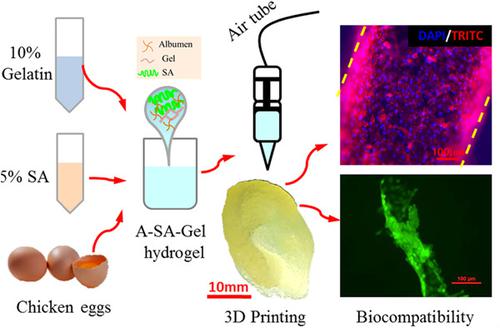当前位置:
X-MOL 学术
›
Biotechnol. Bioeng.
›
论文详情
Our official English website, www.x-mol.net, welcomes your feedback! (Note: you will need to create a separate account there.)
3D printing of self-standing and vascular supportive multimaterial hydrogel structures for organ engineering
Biotechnology and Bioengineering ( IF 3.8 ) Pub Date : 2021-10-07 , DOI: 10.1002/bit.27954 Suihong Liu 1, 2 , Qingxi Hu 1, 2, 3 , Zhipeng Shen 1 , Sasirekha Krishnan 4 , Haiguang Zhang 1, 2, 3 , Murugan Ramalingam 4
Biotechnology and Bioengineering ( IF 3.8 ) Pub Date : 2021-10-07 , DOI: 10.1002/bit.27954 Suihong Liu 1, 2 , Qingxi Hu 1, 2, 3 , Zhipeng Shen 1 , Sasirekha Krishnan 4 , Haiguang Zhang 1, 2, 3 , Murugan Ramalingam 4
Affiliation

|
Three dimensional printable formulation of self-standing and vascular-supportive structures using multi-materials suitable for organ engineering is of great importance and highly challengeable, but, it could advance the 3D printing scenario from printable shape to functional unit of human body. In this study, the authors report a 3D printable formulation of such self-standing and vascular-supportive structures using an in-house formulated multi-material combination of albumen/alginate/gelatin-based hydrogel. The rheological properties and relaxation behavior of hydrogels were analyzed before the printing process. The suitability of the hydrogel in 3D printing of various customizable and self-standing structures, including a human ear model, was examined by extrusion-based 3D printing. The structural, mechanical, and physicochemical properties of the printed scaffolds were studied systematically. Results supported the 3D printability of the formulated hydrogel with self-standing structures, which are customizable to a specific need. In vitro cell experiment showed that the formulated hydrogel has excellent biocompatibility and vascular supportive behavior with the extent of endothelial sprout formation when tested with human umbilical vein endothelial cells. In conclusion, the present study demonstrated the suitability of the extrusion-based 3D printing technique for manufacturing complex shapes and structures using multi-materials with high fidelity, which have great potential in organ engineering.
中文翻译:

用于器官工程的自立式和血管支撑多材料水凝胶结构的 3D 打印
使用适用于器官工程的多种材料的自立和血管支撑结构的 3D 可打印配方非常重要且极具挑战性,但它可以将 3D 打印场景从可打印形状推进到人体的功能单元。在这项研究中,作者报告了这种自立式和血管支撑结构的 3D 打印配方,该配方使用内部配制的蛋白/藻酸盐/明胶基水凝胶的多材料组合。在印刷过程之前分析了水凝胶的流变特性和松弛行为。通过基于挤压的 3D 打印检查了水凝胶在各种可定制和自立结构(包括人耳模型)的 3D 打印中的适用性。结构、机械、系统地研究了印刷支架的理化性质。结果支持具有自立结构的配制水凝胶的 3D 可打印性,可根据特定需求进行定制。体外细胞实验表明,当用人脐静脉内皮细胞进行测试时,配制的水凝胶具有优异的生物相容性和血管支持行为,内皮芽形成的程度。总之,本研究证明了基于挤压的 3D 打印技术适用于使用具有高保真度的多种材料制造复杂形状和结构,这在器官工程中具有巨大潜力。可根据特定需求进行定制。体外细胞实验表明,当用人脐静脉内皮细胞进行测试时,配制的水凝胶具有优异的生物相容性和血管支持行为,内皮芽形成的程度。总之,本研究证明了基于挤压的 3D 打印技术适用于使用具有高保真度的多种材料制造复杂形状和结构,这在器官工程中具有巨大潜力。可根据特定需求进行定制。体外细胞实验表明,当用人脐静脉内皮细胞进行测试时,配制的水凝胶具有优异的生物相容性和血管支持行为,内皮芽形成的程度。总之,本研究证明了基于挤压的 3D 打印技术适用于使用具有高保真度的多种材料制造复杂形状和结构,这在器官工程中具有巨大潜力。
更新日期:2021-12-04
中文翻译:

用于器官工程的自立式和血管支撑多材料水凝胶结构的 3D 打印
使用适用于器官工程的多种材料的自立和血管支撑结构的 3D 可打印配方非常重要且极具挑战性,但它可以将 3D 打印场景从可打印形状推进到人体的功能单元。在这项研究中,作者报告了这种自立式和血管支撑结构的 3D 打印配方,该配方使用内部配制的蛋白/藻酸盐/明胶基水凝胶的多材料组合。在印刷过程之前分析了水凝胶的流变特性和松弛行为。通过基于挤压的 3D 打印检查了水凝胶在各种可定制和自立结构(包括人耳模型)的 3D 打印中的适用性。结构、机械、系统地研究了印刷支架的理化性质。结果支持具有自立结构的配制水凝胶的 3D 可打印性,可根据特定需求进行定制。体外细胞实验表明,当用人脐静脉内皮细胞进行测试时,配制的水凝胶具有优异的生物相容性和血管支持行为,内皮芽形成的程度。总之,本研究证明了基于挤压的 3D 打印技术适用于使用具有高保真度的多种材料制造复杂形状和结构,这在器官工程中具有巨大潜力。可根据特定需求进行定制。体外细胞实验表明,当用人脐静脉内皮细胞进行测试时,配制的水凝胶具有优异的生物相容性和血管支持行为,内皮芽形成的程度。总之,本研究证明了基于挤压的 3D 打印技术适用于使用具有高保真度的多种材料制造复杂形状和结构,这在器官工程中具有巨大潜力。可根据特定需求进行定制。体外细胞实验表明,当用人脐静脉内皮细胞进行测试时,配制的水凝胶具有优异的生物相容性和血管支持行为,内皮芽形成的程度。总之,本研究证明了基于挤压的 3D 打印技术适用于使用具有高保真度的多种材料制造复杂形状和结构,这在器官工程中具有巨大潜力。



























 京公网安备 11010802027423号
京公网安备 11010802027423号